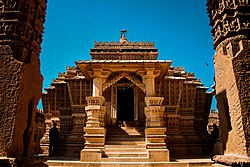Lodhruva
Lodrawa
Lodurva, Lodarva or Laudrava | |
|---|---|
 | |
| Country | India |
| State | Rajasthan |
| District | Jaisalmer |
| Founded | 8th century CE |
| Founded by | Rawal Deoraj |
| Government | |
| • Type | Village |
| Languages | |
| • Official | Hindi, Rajasthani |
Lodrawa (aka Lodurva, Lodarva or Laudrava) is a village in Jaisalmer district, Rajasthan, India. It is located 15 kilometers to the north-west of Jaisalmer. Lodrawa was the ancient capital of the Bhati Rajputs until Rawal Jaisal founded the Jaisalmer state and moved the capital to Jaisalmer in 1156 CE.[1][2][3]
The village and the surrounding area are famous for their historic temples, mostly Jain, originally constructed in the pre-12th-century Maru-Gurjara style of the Chalukya Empire and reconstructed in a similar but more ornate revivalist style in the 17th century.
History
[edit]Rawal Deoraj of the Bhati clan established Lodhruva as the capital in the 8th century CE.[4][5] The city stood on an ancient trade route through the Thar Desert, which also made it vulnerable to frequent attacks. Mahmud of Ghazni laid siege on the city in 1025 CE. It was again ransacked by Muhammad Ghori in 1152 CE, leading to its abandonment and the establishment of the new fortified capital of Jaisalmer by Rawal Jaisal in 1156 CE. Jaisalmer was situated 16 km away on the Trikuta Hill, where the present fortress stands today.[6][7]
Lodrawa was also the setting for the doomed love story of Princess Mumal and Mahendra, a prince of Amarkot, recounted in local folklore and songs.[8]
Visitor's attractions
[edit]Lodrawa is a popular tourist destination, known for its architectural ruins and surrounding sand dunes.[9] Lodrawa is also famous for the Jain temple dedicated to the 23rd Tirthankara, Parshvanatha. The original temple was destroyed in 1178 AD when Muhammad Ghori attacked the city, but it was reconstructed by Seth Tharu Shah in 1615, with further additions in 1675 and 1687.[10] Restored using state-of-the-art methods in the late 1970s, the temples are reminders of the city's former glory.[11] Other old temples in the area are dedicated to the deities Rishabhanatha, Sambhavanatha, Hinglaj Mata, Chamunda, and Shiva.
Further reading
[edit]- Beyond The Dunes: Journeys In Rajasthan, by Juhi Sinha. Penguin Global. ISBN 978-0-14-306306-3.
See also
[edit]References
[edit]- ^ Singh, Ranjeni A (31 May 2002). "Jawahar Niwas: Grace of Jaisalmer". The Economic Times. Archived from the original on 3 November 2013. Retrieved 14 June 2019.
- ^ "Bada Bagh". Department of Tourism, Government of Rajasthan. Archived from the original on 15 December 2012. Retrieved 21 December 2012.
- ^ "About Jaisalmer". Department of Tourism, Govt. of Rajasthan. Archived from the original on 28 December 2012. Retrieved 21 December 2012.
- ^ Tod, James Tod (1832), Annals and Antiquities of Rajast'han: Or the Central and Western Rajpoot States of India, vol. 2, Smith, Elder and Company
- ^ The Rough Guide to India. Rough Guides.
- ^ "Sonar Qila". Financial Express. 9 January 2004.
- ^ Lindsay Brown; Amelia Thomas (2008). Rajasthan, Delhi & Agra (Lonely Planet Travel Guides). Lonely Planet. p. 335. ISBN 978-1-74104-690-8.
- ^ "A story around every dune Published: Sunday". DNA. 24 February 2008.
- ^ "Camel safari in India". Sunday Observer. 15 July 2007. Archived from the original on 29 April 2014. Retrieved 14 June 2019.
- ^ "Jain Temples Jaisalmer". Jaindharm online. Archived from the original on 18 August 2007. Retrieved 14 June 2019.
- ^ Lindsay Brown; Amelia Thomas (2008). Rajasthan, Delhi & Agra (Lonely Planet Travel Guides). Lonely Planet. p. 335. ISBN 978-1-74104-690-8.



